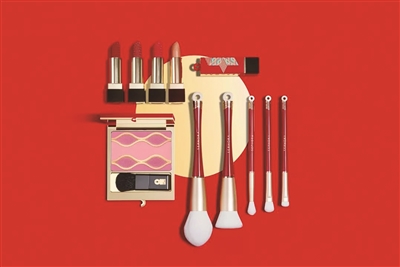
The limited edition "CHINA RED" of Sephora China's makeup collection created by centdegrés Photo provided to Hangzhoufeel

Matthieu Rochette-Schneider
By Zhu Jingning
China has seen a surge in young consumers' interest in brands and products that incorporate the Chinese traditional styles and cultural elements in the past few years, but you may not be aware that the designs of some perfumes and cosmetics in your daily life may come from this man's creation—Matthieu Rochette-Schneider from Saint-étienne, France.
Spending his tenth year in Shanghai as centdegrés法尚 China general manager, he has been advising and working with both local and global companies on their branding strategy, brand creation, visual identity and retail strategy.
Graduated from both l'Ecole Nationale d'Architecture de Saint Etienne and l'Ecole d'architecture de Paris-Belleville, and trained architect, Matthieu has been since working for the creative agency centdegrés in Paris and China. In parallel, he is also a board member at the French Chamber of Commerce and co-president of the Young French Speaking Entrepreneur Association in China.
From industries of beauty to F&B to hospitality, Matthieu's clients include Herborist, Maysu, Chando, Martell, Sephora China… Through his work, he tries to follow his leitmotiv: "created in China" with a French touch. He strives to make people from different cultures understand the Chinese culture from his creations and interpretation of the products.
By mixing TCM elements with his modern design, his team has completely redesigned the brand identity and products of Chinese herbal skin care brand Herborist by using the resilient bamboos to highlight the Chinese features at your first glimpse.
Similarly, they have created a limited edition of Sephora Collection which embodies the passionate and ongoing liveliness of the China RED rooted in the Chinese ethnicity. The team even released a book named The 100 Reds of China where people can discover the shades of red through their cultural interpretation, both ancient and modern.
When it comes to the relationship between design and culture, Matthieu says, "Design is a projection of culture, always oriented to the local culture of the target object." Product design attaches special importance to user experience needs via the customer portraits. He believes that the Chinese and French markets are similar, and the consumers also share many similarities in their preferences. For example, people like to communicate with each other at dinner or on parties, since food gives them a strong sense of identity of their own culture. To better understand the current fashion trend in China, a website named "Created in China" was launched by him to welcome everyone to contribute their ideas.
To gain deeper insights into China's regional culture and heritages, Matthieu has become a frequent traveler to China's major cities and more hidden places, who likes touring around the unfamiliar places by taxi.
He is full of curiosity all the time, and communicates with his Chinese colleagues frequently, sharing French culture with them and getting inspirations from cultural collisions.
This year, Matthieu accepted a new challenge by settling the first Chinese-French institute of design in China between l'Ecole de design Nantes Atlantique and China Academic of Art in Hangzhou: NACAA. As the deputy dean of the new institute, he goes deeper in his love for promoting education, creation and cultural exchange between China and France.
Yu Jian, dean of China Academy of Art International Collaboration Institute, expresses his appreciation for Matthieu's dedication and passion and has a high expectation for the international collaboration between the schools and companies.
Hangzhou has greatly inspired Matthieu. Every time when he comes to this fast-growing city, he finds new hidden and heritage buildings and learns more about the local culture and its secrets. He has never drunk tea in France but fell for tea culture in Hangzhou, as tea is to Chinese people as wine to French.
What impresses Matthieu most is the Qiantang River Bridge, an important and symbolic image in his mind, just like the work he is doing now, contributing to an artistic bridge connecting China and France.
In Matthieu's eyes Hangzhou is potentially at the forefront of the design field. He has planned to have more business development in the city, including setting up a branch of centdegrés法尚, and joining hands with local brands to go global.
In front of Matthieu lies huge possibilities while he holds firm to his principle: Do more, and do it right away.